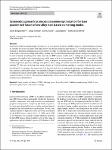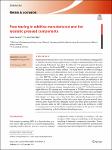Search
Author
- Lorenz, Fuchs (1)
- Lukas, Gerhold (1)
- Mayr, Peter (1)
- Nudelis, Natan (1)
- next >
Subject
- AlSi10Mg (1)
- Systematic (1)
Date issued
- 2023 (2)
Has File(s)
- true (2)
Search Results
In the metal additive manufacturing (AM) process of laser powder bed fusion (LPBF), there are a limited number of materials suitable for producing parts with high density and desired mechanical properties. To establish novel materials, it is essential to determine optimized process parameters in order to overcome process-related challenges and mitigate defects such as lack of fusion, keyholing, and balling. Scaling laws based on thermophysical properties and process parameters can be used to transfer knowledge from other materials or LPBF systems. In this work, a scaling law is used to adjust process parameters for single-track experiments over a wide range, which are laser power PL (100–1000 W), scan speed vs (300–2500 mm/s), and laser spot size ds (0.08–0.25 mm). |
Despite past scientific efforts and the increased use of hot isostatic pressing (HIP) in additive manufacturing applications, a complete understanding of the exact pore-closing behaviour has yet to be achieved. The present research focuses on laser powder bed fused (LPBF), hot isostatic pressed components made of AlSi10Mg, and process-related defects. The study shows the effect of HIPing in relation to various pore characteristics, such as pore shape, size, and type. A pore tracing method using X-ray data was developed to characterise the pores before and after HIP. The method is based on the k-nearest neighbours approach and allows to match leftover pores with the initial ones. Hence, the efficiency of the pore-closing behaviour for different HIP settings can be analysed. Moreover,... |


